Koshari (The National Dish of Egypt)
This post may contain affiliate links. See my disclosure policy.
The national dish of Egypt, Koshari is a vegetarian dish that features rice, lentils, macaroni pasta, garbanzo beans, and crispy fried onions all tied together with a spicy tomato sauce. It’s Egyptian street food at its best and this authentic koshari recipe is one you’ll make again and again!
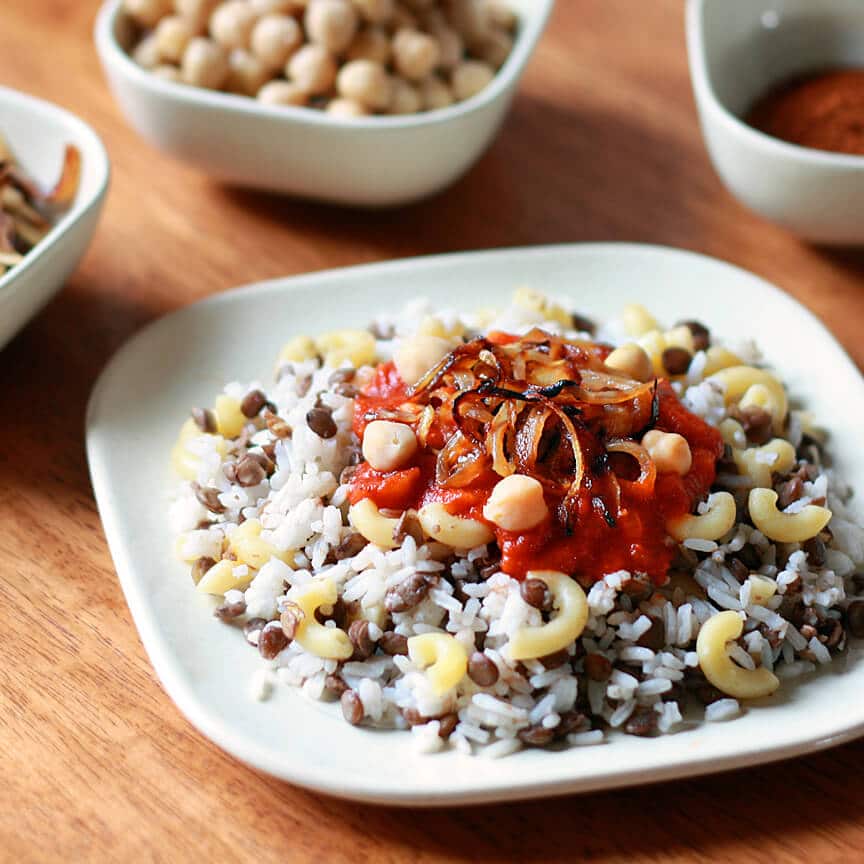
This koshari recipe is one of the very first recipes I published on my blog back in early 2013. Soon thereafter it was featured in magazines and across the web. It has remained a favorite in our home and I hope you’ll enjoy it as much as we do!
What is Koshari?
During my time as college student doing a study abroad in Jerusalem with trips Egypt, Jordan and Lebanon, I took advantage of the opportunity to delve into the local cuisines, to talk as best I could with local cooks and spice merchants, and enjoy every moment of it. When I was in Egypt one of the first dishes I sampled was koshari, served up hot by a street vendor. Koshari (also spelled Koshary or Kushari) is the national dish of Egypt and it’s served in virtually every Egyptian restaurant, in every Egyptian home, and on every Egyptian street corner. Street vendors serve the dish from carts to people eagerly waiting in line to eat this popular dish. An unusual combination, Koshari mixes lentils, macaroni noodles and rice into a single dish and it’s then topped with a spicy tomato sauce and the dotted with garbanzo beans and fried onions. It’s one of those dishes that may not sound terribly exciting from the description alone. But then you taste it. And then you understand why this dish is a favorite among Egyptians.
Egyptians and tourists fondly speak of the “Koshari Man,” the title bestowed upon street vendors who sell the dish from their carts. Aziz Awad, who used to be a Koshari street vendor and now works at a downtown restaurant, describes it this way: “The Koshari man grabs a bowl, and scoops a little of each ingredient into the bowl….Each Koshary dish takes about five seconds to [assemble]. His speed can be surprising to you. I have worked here since we opened 10 years ago, and before that I sold Koshary on a street cart, so I have to be fast. My hands are accustomed to the same movements I do all day everyday, so you can say that I memorized the movements rather than think about them” (source www.touregypt.net). I had the privilege of watching such a Koshari Man in action as he assembled my koshari and what seemed like the speed of light.
Every Egyptian knows and recognizes the sound of Koshari being made from down the street. Heba Fatteen Bizzari explains, “As the Koshari man scoops, he knocks his metal spoon against the sides of the bowls, making the Koshari symphony that you won’t hear elsewhere. When the Koshari man prepares an order of more than four the restaurant fills with sound as if it was a rehearsal for a concert. The restaurants of Koshari are very noisy. One sits to eat while the Koshari man practices his drums in your ears” (source www.touregypt.net).
Where Did Koshari Originate?
Interestingly, although it is Egypt’s national dish, it isn’t actually Egyptian in origin. Neither rice nor macaroni are indigenous to Egypt. It is believed that Koshari originated in India and dates back to the time of British Colonization. The name “Koshari” is actually from the Hindu “khichri”, which refers to a dish of lentils and rice (in fact India has a popular lentil and rice dish called kitchari). When the British arrived in Egypt in the late 1800’s they brought this dish with them – it was inexpensive and filling. It didn’t take long before the dish was enthusiastically embraced by the Egyptian people.

Key Ingredient: Baharat
The crowning aspect of this dish is the flavor-packed, spicy tomato sauce. It’s made with a special Middle Eastern spice blend called Baharat (Arabic for “spice”), an all-purpose spice blend commonly used in Middle Eastern cuisine. Just a pinch adds depth and flavor to sauces, soups, stews and meat. I stocked up on on a myriad of Middle Eastern spices when I was in the Middle East, studied them extensively when I got home, and have been making my own spice blends since. Yep, in the picture below that’s me in one of the many, many spice shops I visited throughout the Middle East as a study abroad college student.
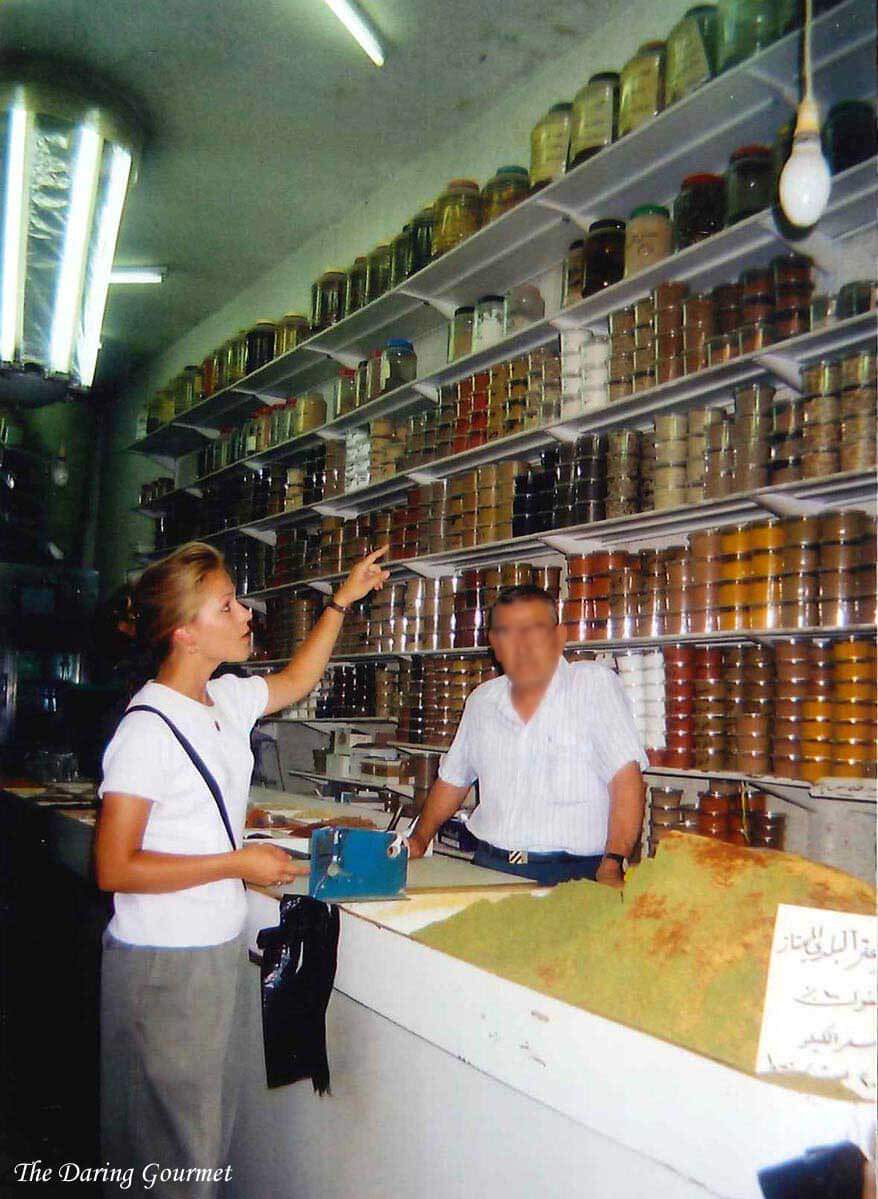
Unless you have a Middle Eastern store in your area or order it online, this spice blend can be challenging to find. However, as with any spice blend, it’s practically a hundred times better made fresh in your own kitchen anyway. The flavors are more robust and vibrant and homemade baharat will seriously transform your koshari.
Check out my homemade authentic Baharat recipe!
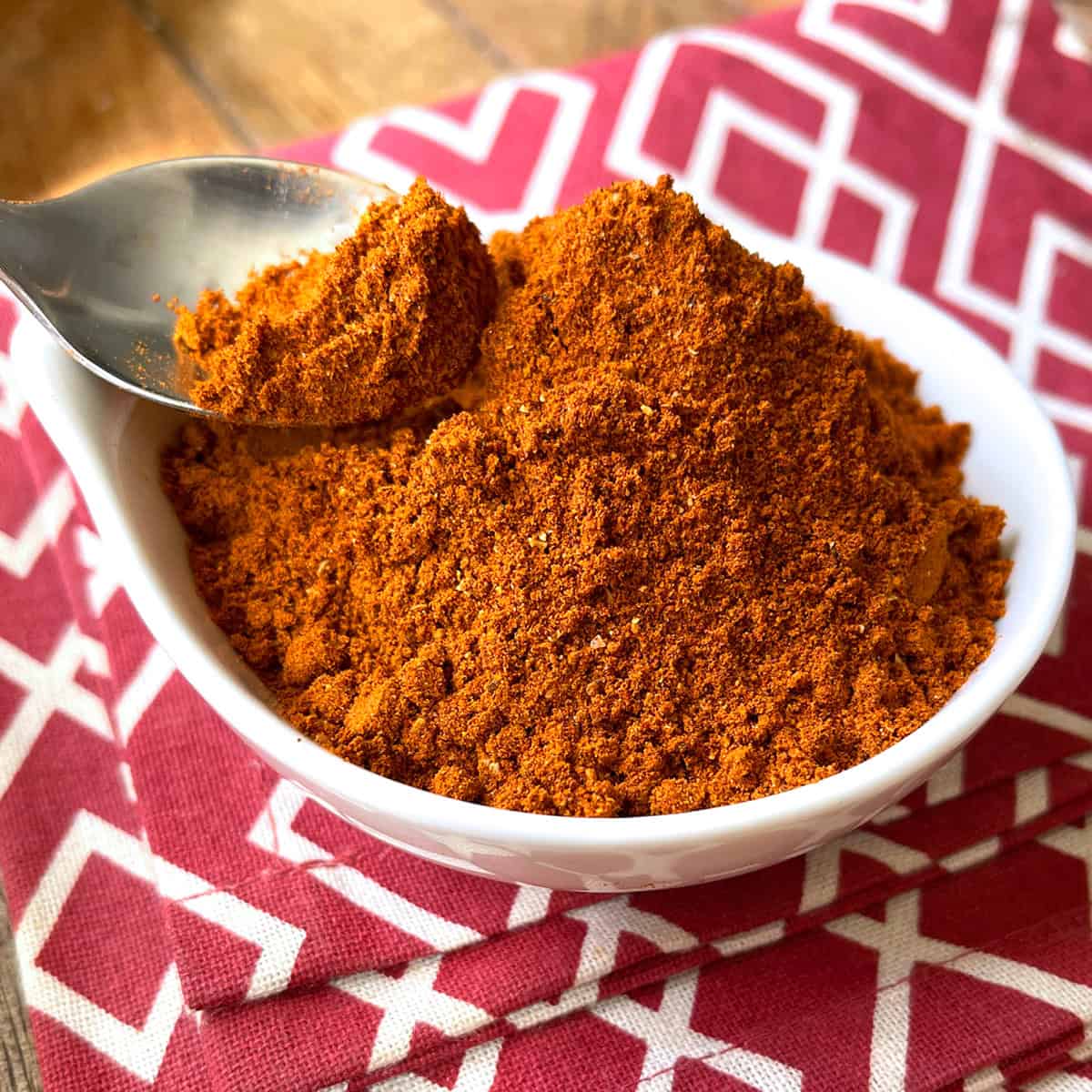
Koshari Recipe
This recipe is very authentic and simple to make, but be prepared to dirty up a few pots! Here’s how to make it:
- Make the Rice: Heat 2 tablespoons of olive oil in a medium saucepan over medium-high heat. Add the rice and fry it for 2 minutes, then add the vegetable stock. Bring it to a boil, decrease the heat to low, cover and simmer for 15 minutes or until the rice is cooked. Leave in the pot to keep warm and set aside.
- Make the Lentils: Rinse the lentils under cold water and add them to another medium saucepan with 2 cups of water. Add the garlic, cumin and bay leaf and bring it to a boil. Reduce the heat to low, cover and simmer for 20-30 minutes or until the lentils are tender. Once cooked, add the salt and stir to combine. Strain any excess liquid if necessary. Leave in the pot to keep warm and set aside.
- Make the Macaroni: Cook the macaroni according to package instructions until al dente. Leave in the pot to keep warm and set aside.
- Make the Sauce (do this while the rice, lentils and macaroni are cooking or it can also be made up to a day in advance): Heat the oil in a medium saucepan over medium-high heat and add the onion. Cook until soft and translucent, about 5-7 minutes. Add the garlic and saute until golden brown. Add the tomato sauce, baharat, salt and pepper to taste, chile flakes (if using) and red wine vinegar. Bring it to a simmer, reduce the heat to low, cover and simmer for 20 minutes, stirring occasionally.
- Make the Crispy Onions: Heat the oil in a skillet. Add the onions and fry until dark brown. Using a slotted spoon, remove them from the oil and place them on paper towels to drain and cool. Set aside.
- Assemble the Koshari: Add the rice, lentils and macaroni to a large bowl and toss to combine (or simply scoop out desired amounts of each onto the plates). Sprinkle a little baharat over each portion and serve topped with some of the spicy tomato sauce. Top with garbanzo beans, the crispy onions and another sprinkle of baharat. Serve warm.
Each of these components can be made up to a day in advance and then simply reheated and assembled. It’s the perfect make-ahead dish!
Enjoy!
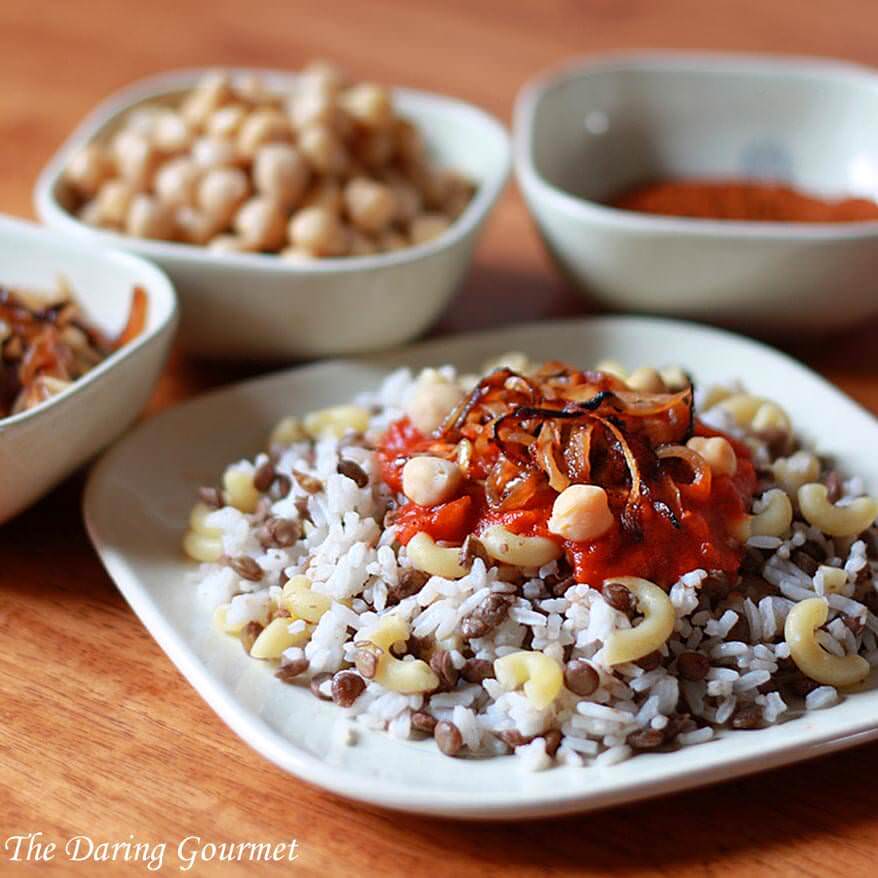
For more authentic Middle Eastern recipes be sure to try my:
- Harira
- Falafel
- Za’atar
- Chicken Machboos
- Lavash
- Dukkah
- Djej Makalli
- Kusksu
- Hummus
- Moroccan Chicken Tagine
- Preserved Lemons
- Baba Ganoush
- Tahini
Save This Recipe
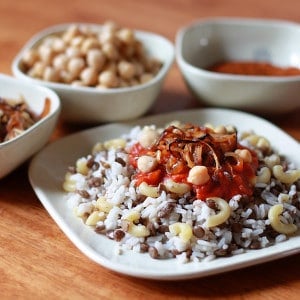
Koshari (The National Dish of Egypt)
Ingredients
- 2 tbs olive oil
- 1 cup medium grain rice
- 1 cup brown lentils
- 2 cups small uncooked macaroni noodles (Gluten Free: use GF pasta)
- 2 cups vegetable broth
- 1 garlic clove , quartered
- 1 teaspoon cumin
- 1 bay leaf
- 1/2 teaspoon salt
- Salt to taste
- For the Sauce:
- 2 tablespoon olive oil
- 1 small onion , diced finely
- 2 cloves garlic , finely minced
- 1 15 ounce can plain tomato sauce
- 2-3 teaspoons baharat spice blend
- Homemade Baharat , click link for recipe (strongly recommended for the best flavor!)
- 1/4 teaspoon red chile flakes (omit if you don't like it spicy hot)
- 1 tablespoon red wine vinegar
- Salt & pepper to taste
- Crispy Onion Garnish:
- 2 large onions , very finely sliced
- Oil for deep-frying
- 1 15 ounce can garbanzo beans , rinsed and drained
Instructions
- Make the Rice: Heat 2 tablespoons of olive oil in a medium saucepan over medium-high heat. Add the rice and fry it for 2 minutes, then add the vegetable stock. Bring it to a boil, decrease the heat to low, cover and simmer for 15 minutes or until the rice is cooked.Make the Lentils: Rinse the lentils under cold water and add them to another medium saucepan with 2 cups of water. Add the garlic, cumin and bay leaf and bring it to a boil. Reduce the heat to low, cover and simmer for 20-30 minutes or until the lentils are tender. Once cooked, add the salt and stir to combine. Strain any excess liquid if necessary.Make the Macaroni: Cook the macaroni according to package instructions until al dente.Leave each of these in the pot to keep warm and set aside.
- Make the Crispy Onions: Heat the oil in a skillet. Add the onions and fry until dark brown. Using a slotted spoon, remove them from the oil and place them on paper towels to drain and cool.
- Make the Sauce: Heat the oil in a medium saucepan over medium-high heat and add the onion. Cook until soft and translucent, about 5-7 minutes. Add the garlic and saute until golden brown. Add the tomato sauce, baharat, salt and pepper to taste, chile flakes (if using) and red wine vinegar. Bring it to a simmer, reduce the heat to low, cover and simmer for 20 minutes, stirring occasionally.
- Assemble the Koshari: Add the rice, lentils and macaroni to a large bowl and toss to combine (or simply scoop out desired amounts of each onto the plates). Sprinkle a little baharat over each portion and serve topped with some of the spicy tomato sauce. Top with garbanzo beans, the crispy onions and another sprinkle of baharat. Serve warm.Note: Each of the components can be made well in advance and then simply reheated and assembled.
Nutrition
Originally published on The Daring Gourmet February 21, 2013



















When I saw this in the cold case in a Mediterranean deli I was told “it’s an Egyptian dish” and was intrigued. I bought some and kinda liked it. Found your recipe and decided to make it since all the ingredients were in my pantry and I found the spice mix in the international section of my grocery store. I enjoy learning about ethnic dishes and this was a new one for me! Yes, it’s a carb overload but I served it as a side to some oven baked chicken thighs and a salad. My husband and I both enjoyed it and I’ll make it again, particularly since I have lots of time now staying home. I did use chicken broth for the recipe for more depth of flavor over vegetable stock. Thanks for the recipe!
Wonderful, Alicia, I’m so glad you both enjoyed it, thank you!
I have lived in egypt for 15 years and went back home last year. This recipe was exactly like the Koshari made in egypt. Although it’s full of carbs and as one of the comments here . I don’t know if you lived in egypt but the Egyptian eat like this. I’d stand in d supermarket and stare at they carts full of pasta rice oil potatoes. When I say full I mean full , lots n lots of oil and packets of pasta. So maybe it’s just the way they eat but the recipe is spot on I just wanted you to know. It was really lovely and I enjoyed it this afternoon. I even stored the spice I ground it smelled divine..
Thank you so much for that feedback and those insights, Gillian, I appreciate it!
Yup great dish would love some day to try the street edition
I loved this! What a wonderful flavor and texture experience! Much depth!
Thank you, Susan, I’m so glad you enjoyed it!
I am so sorry. I really can’t get excited about this. I followed all the instructions to the letter and cooked everything as the recipe required. It took a long time, but I finally dished it up, and all I really thought when I had finished eating, was just how much stodge I had just eaten. Rice, pasta lentils, chickpeas… there was no variety of density it just felt heavy and starchy, with no different textures or sensation. It just felt like a huge effort, just to chew each mouthful! Well at least I know I won’t be making it again. One type of carbohydrate-rich ingredient is ok. 4 at once, is a definite overload, no matter how nutrient-rich they all might be. It’s too much heavy density at once. You might as well add fried potatoes to it, and finish off the carb spectrum!
This is a lot of work for a bulky result, even with the tomato sauce. It’s the sauce that is actually the only thing that literally holds it all together. Without it, it’s just a mélange of bulk. Incidentally, I am an experienced cook, and have worked in professional kitchens, so I do have a slight edge over many domestic Goddesses…
You should go to Egypt and have it there, along with a felafel sandwich. The history of this dish will help make sense of its ingredient combination. At least you tried and now you know, not every dish out there will be your cup of tea. For Egyptians and those of us who’ve tasted it in the motherland, it is a winner! Plus, YAY, it’s vegan :)
Nice! Delicious!
If you want to get more flavor, cook the lentils with the rice. Then you get both their flavors. Or better yet, let each ingredient sit inside water overnight (separately), then cook them together. Also, the onions need to be very crispy, so make sure that they are.
A friend who visited Cairo kept raving about Koshari, so when he came for dinner, we looked up a recipe on the internet and came across your site. I liked what I read about the dish and the particular mix of ingredients (which according to our friend was authentic), so we gave it a try. Needless to say, it has been a hit ever since and is a regular in our rotation of menus. Thank you!
That’s wonderful, Tania, I’m so glad to hear that, thank you!
My son is making this for his potluck at his Arabic class. We have to prepare everything the night before I will prepare the lentils, macaroni, sauce, and rice, in advance and store in Tupperware. What’s the best way to put everything together the next day? Should I heat everything up individually and then mix it, or mix it all together while cold and warm it up in the oven before putting the sauce on?
Hi Cindy, that sounds like a fun and tasty potluck. Yes, you can just mix everything up, reheat it and add the sauce.
I wanted to try making this but I can only get tomato puree “double concentrate” in small cans, how much of this should be used and how much should it be diluted?
Hi Mark, yes that’s no problem. Dilute it with water using a 1:1 ratio (1 cup water per 1 cup tomato puree). Happy cooking!
Growing up in Egypt Koshary was definitely a very delicious vegan dish.
Only street vendors had that tasty twist that was never mastered by our parents who cooked it for us at homes.
To the best of my memory 40 years ago the original ingredients were rice and black lentils. No vermicelli, no garbanzo beans…maybe pasta…?
Those ingredients were added through the years as lentils were getting pricey and frequently there would be shortage of rice supply.
This dish needed to stay affordable to its original clientele: the workers who can’t afford meat as a source of protein.
Then doubtless the rest of the recipe is a must, the red sauce the extra vinegar+ garlic mix and the challenging golden crispy onions are the whole world that make this dish what it is. Did anyone mention that the crispy onions are called “ward” Arabic for roses!!
We grew up in Egypt knowing white vinegar only, and for an odd reason the Mediterranean brands have a different taste or maybe they’re less tangy so for that dish I don’t use the American vinegars.
As for nutrients, I read years ago, so please double check this information that when you COOK rice and lentils (or beans in genera?) together the amino acids add up to 23 whereas meat has 25 amino acids.
My mom used to cook the lentils halfway, then added uncooked rice for the mix to cook in full slowly together. That was a challenging step to get them both at a perfect doneness and nice texture…so I skipped the nutrition advantage and resorted to the practical way of cooking rice and lentils separately.
Of course I add elbow pasta to make it more kid friendly and yes although I am a sloppy cook, still my boys love this flavorful…and still nutritious dish.
“Street koshari” is the best compliment I give to any lady who masters that intricate dish.
Oh my. This is it! That’s the spice blend I have been looking for. Now, while I have never had Koshuri in Egypt, the late Anthony B. (R.I.P. Anthony) Egypt episode of No Reservations sent me searching. I found a place here in Phoenix that serves it, and no recipe I have found had what I was tasting in the tomato sauce. I have read many recipe’s that contained this, this, and this, and I just said “No, that is not the depth of flavor I am tasting”…until now. SPOT ON Kimberly, spot on. Bravo! Made this for my mom, and sister. It’s a hit! Thank you so much for your travels, and your blog. This, and the Baharat recipe have been pinned, as well as a few others. :)
I’m so thrilled to hear that, Gary, thanks so much for the feedback!
Thank you so much for this recipe and the Baharat recipe. I tried this dish at a restaurant this weekend and immediately fell in love. Unfortunately, the restaurant is two hours from where I live so it’d be hard to fulfill any cravings. I made your recipe last night with a few tweaks and it was so good. The sauce is almost identical to the restaurant. I made barley instead of rice & pasta since I’m cutting back on starches for my diet and it was fantastic. I love trying new vegetarian friendly dishes. Definitely adding this one to my repertoire.
So glad you enjoyed it, Dani, thank you!
I recently discovered this recipe and it is so fabulous I’d like to have it every day! The sauce alone is so good I’m going to make a batch of it to use on pasta. Thank you!
Wonderful, Jules, thanks so much!
Thank you so much for the recipe. I am dating someone from Egypt so I thought it was time to learn new recipes. I made it for my family first and they loved it. The real test will come when he tries it. By the way, I followed your recipe for the blended spice Baharat….awesome…loved it!
Awesome, Pauline, and I’m so glad you made the Baharat! Thanks so much and yes, please let us know what your boyfriend thinks when he tries it.
Thank you for the wonderful recipe and for sharing the experience behind it. Suqs in Muharraq, Madinat at Isa and Bab al abahrain are ideal places to go looking for the perfect spices. Preparing Baharat from scratch sure improves the flavours so much than stores bought pack.
Thanks for the tips, Johnson, and I agree – nothing compares to making spice blends from freshly toasted and ground whole spices.
What s The vegetable stock please ? Thank you
Vegetable broth.
Thank you so much! I’ve just rediscovered koshari and was so happy to be able to make this with my (currently) barely-stocked pantry ingredients. Absolutely love the accompanying baharat recipe; I had to go with your koshari after seeing what the baharat entailed. Will definitely be doing some research to find what else I can use it in.
Wonderful, Sonja, I’m so glad you enjoyed it, thank you!